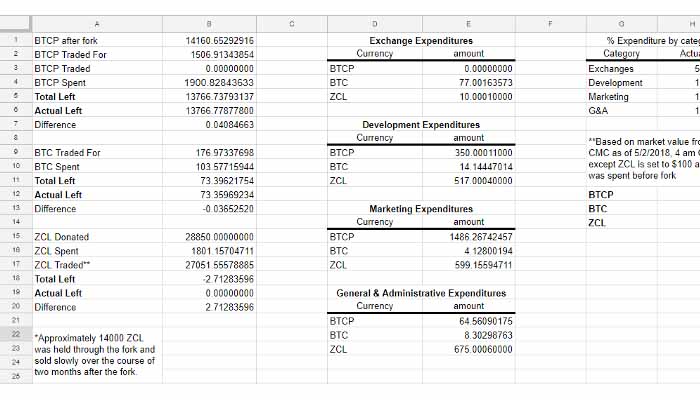What Is Bitcoin Private?
The web made the biggest data sharing enunciation point ever. While there are innumerable points of interest to the effortlessly open store of data, people have been required to surrender their protection in return. Over and over again, and through no blame of the end client, an outsider with lacking security is ruptured and delicate data is imperiled or stolen.
A superior framework is required that expels trusted brokers and enables any two people to unreservedly and safely execute. Another cryptographic money, Bitcoin Private, is introduced in this as a low-expense, quick, and private value-based system — a genuine satisfaction of Bitcoin maker Satoshi Nakamoto's guide. Bitcoin Private is the result of a fork-converge of Bitcoin with Zclassic.
The subsequent Bitcoin Private chain has essentially bring down charges than Bitcoin, alongside exchange speeds four to six times quicker. Above all, zk-SNARKs, an associate audited protection innovation initially executed by the Zcash Foundation is joined. zk-SNARKs takes into account provably mysterious and private exchanges — an achievement no other security innovation can guarantee.
The UTXO sets of both Zclassic and Bitcoin will include the underlying coins in this new record. This implies roughly 20.4 million out of 21 million coins will exist at fork time, guaranteeing that Bitcoin Private will have the most reduced expansion to ever exist in the digital money universe. Taking everything into account, this white paper talks about Bitcoin Private, its mechanical preferences, the business pertinence, and the chain's potential for future improvement and also its locale driven core interest.
- Overview - Table of Contents
- What Is Bitcoin Private?
- Getting Started With Bitcoin Private
- How To Get A Bitcoin Private Wallet?
- Bitcoin Private Resources
- How To Buy Bitcoin Private?
- How To Earn Bitcoin Private?
- What Is Bitcoin Private Mining?
- Latest Bitcoin Private News
For most of written history, transactions have been private and fairly anonymous. The information of a transaction was only disclosed to the sender and the recipient. Recently, the large majority of financial transactions have become facilitated by technology, making it increasingly difficult to maintain financial privacy.
The most common methods of payment (e.g. credit/debit card, ApplePay, etc.) result in all the information of a transaction being stored digitally. While there are immense benefits that come with these transaction methodologies, it should not preclude the utility of financial privacy for the average consumer. Considering how often breaches occur within large financial institutions resulting in significant leaks of personal and financial information, it is clear there is a need for financial privacy options.1,2 Furthermore, various financial institutions have been caught selling customer data,3 as well as blocking legal transactions with no valid legal basis.
In October 2008, Satoshi Nakamoto released the academic article titled “Bitcoin: A Peer-to-Peer Electronic Cash System” in which the foundation for the first cryptocurrency was detailed.5 Satoshi’s vision was to create a currency which enabled removal of third party institutional control of transactions, limited inflation, and monetary freedom through anonymity.
Since the launch of Bitcoin in 2009, over 1000 different cryptocurrencies have been created and immense progress has been attained.6 Indeed, many new cryptocurrencies far outpace Bitcoin in terms of transaction speed and fees. Regardless, Bitcoin still remains the most popular cryptocurrency due to its first mover advantage and significant number of base-pairs available for trading.
As the Bitcoin blockchain grew through the years, notable issues began to arise including a fixed, small block size (which led to higher-than-practical fees), slow block time (10 min average), long difficulty adjustment period (every 2 weeks), and the development/mass-production of advanced application-specific integrated circuit (ASIC) mining devices (for rapidly calculating SHA-256; this algorithm is a key consensus parameter) leading to further centralization.
In order for Bitcoin to address these items, migration of over 50% of its miners would have to consent to changing the code they are running; to-date, no such event has happened. This has driven the creation of hard forks of Bitcoin (such as Bitcoin Cash and Bitcoin Gold), to enable some of these technological improvements.
For example, Bitcoin Cash remodeled to allow for larger block sizes (≥8 MB vs 1 MB), which reduces fees and increases transaction throughput. However, this did not come without tradeoffs — its price potential was damaged because of its lack of a fixed block-size and “fee market.” The fee market in the Bitcoin mempool challenges transactions big-and-small to compete against the opportunity cost of each other; this makes the value of its ownership even more urgent, causing higher demand.
Bitcoin Gold took another route, instead reducing the block time (2.5 min), switching the PoW algorithm to Equihash (ASIC resistant), and introducing an enhanced difficulty adjustment algorithm, which occurs every block (Bitcoin Cash later instituted a difficulty adjustment of every block in November, 2017).
It largely satisfied its goal as a GPU-compatible Bitcoin fork, but it lacks the widespread adoption of Bitcoin, and the developers performed a premine cash grab which many argue is less than ethical given that it happened behind closed-doors.7 Despite the best of intentions, Bitcoin forks have indisputably remained second to Bitcoin in the cryptocurrency markets as of Q4 2017.
At the core of Satoshi’s vision, many find themselves drawn to technology’s capacity to manifest a deflationary unit of financial value that also allows us to enjoy and leverage anonymity. The “Right to Privacy” is a crowning liberty in the free world,8 and is essential to the principles set forth by Satoshi and the cryptocurrency community.
Financial privacy is a critical principle in Satoshi’s vision of a new digital currency world, however, many people are still stuck at crossroads with pseudo-anonymous transactions on blockchains. Furthermore, there are government and private sector organizations that leverage massive datasets and machine learning to identify the individuals associated with such a transaction.
Indeed, BitFury is capable of de-anonymizing up to 15% of Bitcoin transactions as of January 2018, a figure that increases daily and will markedly alter the cryptocurrency hemisphere in the years to come.9 This lack of privacy in relation to Bitcoin is ironic given the original intent of its creator, although, there exists a solution. Various cryptocurrencies have attempted to solve this privacy issue. Unfortunately, many of these are still capable of being compromised through various techniques, due to their on-chain transaction systems that promise anonymity through obfuscation or TOR nodes.
In 2014, a groundbreaking research paper by MIT researchers discussed “zero-knowledge non-interactive arguments of knowledge”, or zk-SNARKs.10 Remarkably, cryptocurrencies that implement zkSNARKs allow for shielded transactions — funds are completely anonymous with no transaction or address balance appearing on the ledger. In 2016, the authors 3 of this research developed and launched Zcash, the first cryptocurrency to incorporate zk-SNARKs.
A “founder’s tax” was incorporated into the code of Zcash, allowing the development team and early investors to collect 20% of coins mined by the community. After listening closely to the mining community, Rhett Creighton decided to fork Zcash just 8 days later, eliminating the founder’s tax and creating Zclassic - a Zcash platform built on transparency through community development. Unfortunately, Zclassic suffered from the same ideas which it derived its greatness: the absence of a founder’s tax led to a lack of active development.
However, there are various governance methods which can prevent this stale development. Bitcoin Private, a supposed “fork-merge” of Bitcoin and Zclassic, is intended to add privacy and spendability to the Bitcoin blockchain while remaining cognizant of the challenges, choices, and failures of prior forks. To accomplish this, Bitcoin Private will use a larger block size (2 MB), a shorter block time (2.5 min), and an ASIC-resistant (GPU-friendly) proof-of-work (PoW) algorithm for mining — Equihash.
Furthermore, due to the dual nature of this fork-merge, more of the crypto-community will find themselves involved. After the snapshot, ZCL (t & z) and BTC (segwit & normal) addresses will receive BTCP (1:1 for both) at the same address. This is a first-of-its-kind fork and the open source blockchain community is finally beginning to fully explore the malleability of UTXO sets.
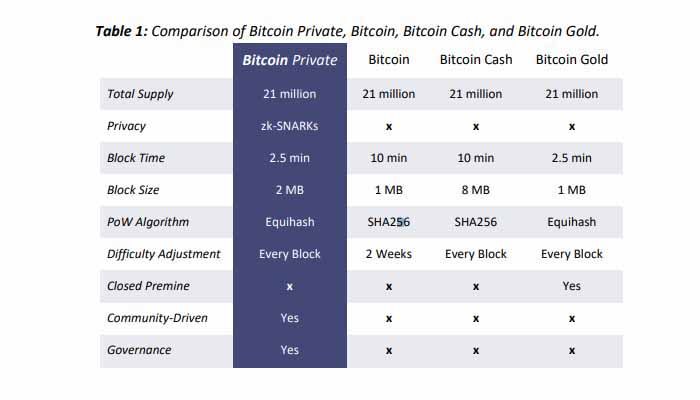
Fork Methodology
For Bitcoin Private, a “fork-merge” is proposed, whereby the UTXOs of two cryptocurrencies are combined into one blockchain. This will formally happen off of the Zclassic blockchain, since zk-SNARKs and JoinSplit transactions are fundamentally part of this new blockchain.
One can liken the solving of a blockchain to a chain-growth polymerization mechanism: when the next block is solved, the blockchain grows, just as a polymer grows upon the reactive addition of monomer to the polymer chain end. However, while longer polymer chains are generally desirable as they impart increased toughness on the resulting plastic, increasing the blockchain size results in increased storage consumption as well as significantly longer node sync times.
Fortunately, this snapshot will only need to retrieve the address state from Bitcoin and Zclassic at a single point in time, which will be carried to the new chain. This approach is effective and results in a significant reduction in storage required by the blockchain, in this case reducing it from 157 GB to only 10 GB (at launch). Additionally, the Bitcoin Private clients will support blockchain pruning and SPV techniques like Electrum in order to reduce the burden of the blockchain on user devices.
A significant issue that any fork must handle is a so-called “replay attack,” in which a post-fork transaction on the original blockchain is made valid on the new blockchain. All coin forks must have replay protection in order to ensure legitimacy and independence from the original blockchain. To safeguard against replay attacks from Bitcoin and Zclassic, Bitcoin Private will feature two-way replay protection.
This is a studied problem, and we are using the industry standard approach which will be incorporated in a two-way manner as stated above. This is already implemented, and we are using the industry standard approach (SIGHASH_FORKID), which is well-studied and has worked successfully for Bitcoin Gold.11 The snapshot of Bitcoin and Zclassic is set for the first blocks timestamped after 5 PM UTC on February 28, 2018, with the fork/main-net launch occurring approximately 2 days later.
After launch, there will be approximately 700,000 mineable Bitcoin Private. A starting block reward of 1.5625 Bitcoin Private has been selected along with a halving every 210,000 blocks(~1 year). However, if this experiment proves unsuccessful, an alternative plan can be implemented, which is outlined in Section 7.
Proof-of-Work: Equihash
As discussed in the introduction, mining of Bitcoin is predominantly performed by ASICs, specialized instruments capable of significantly outcompeting GPUs. Unlike GPUs, ASICs are far more difficult to acquire and have led to significant centralization of Bitcoin mining. Indeed, Igor Homakov has suggested that over 60% of Bitcoin network hash rate is located in China.12 Meanwhile, ASIC resistant algorithms are far more likely to be decentralized as GPUs are more readily available throughout the world.
Decentralization of the network hash allows for significantly more democratization of the blockchain, decreased susceptibility to a 51% attack, and ensures that the cryptocurrency generated via mining, as well as associated fees collected, are spread throughout the community as evenly as possible. This further prevents the ability of a few miners to influence the blockchain development as well as manipulate the market via mining significantly large amounts of the cryptocurrency.
Bitcoin Private will utilize the highly-regarded Equihash PoW algorithm, which was developed by Alex Biryukov and Dmitry Khovratovich at the University of Luxembourg as an asymmetric proof-of-work (PoW) mechanism.13 Unlike other ASIC-resistant PoW algorithms, Equihash is based on the “Birthday Problem” and the enhanced Wagner algorithm utilized to solve it. Furthermore, Equihash features “memory hardness” whereby a steep computational penalty is associated with a reduction in memory usage and speed.
This feature increases the ASIC resistivity of Equihash due to the cost of implementing more memory into ASICs to make them competitive with GPUs or even CPUs. The authors of the original paper discuss that while memory hardness does not protect against botnet-based CPU mining, the large amount of memory consumption would be extreme, such that the userbase of infected PCs would notice a significant difference in performance and take necessary actions to remove the infection.
Transparent vs. Shielded Transactions
Bitcoin Private is an amalgamation of two transaction systems - transparent and shielded transactions. Transparent transactions operate on the same principles as Bitcoin - input, output, amount, and signature. Sources of all funds, destinations, and amounts are stored transparently on the blockchain. Shielded transactions, conversely, encrypt these details into a special section of a block called the JoinSplit.
These transactions are verifiable but indecipherable to 6 third-party observers. When spending shielded notes, the integrity of the blockchain is kept via a specialized zero-knowledge proof algorithm called zkSNARKs. 6 This algorithm runs a series of computations to show the input values sum to the output values for each shielded transfer.
Then, the sender proves that they have the private spending keys of the input notes, giving them the authority to spend. Finally, the private spending keys of the input notes are cryptographically linked to a signature over the whole transaction, in such a way that the transaction cannot be modified by a party who did not know these private keys.
This entire methodology relies on the Zcash trusted setup: at Zcash launch, keys necessary for zero knowledge proofs and private transactions were generated and subsequently destroyed; this was called “The Ceremony.” 6 By doing this, the system can ensure “one-time strong unforgeability against chosen message attacks.”
Voluntary Miner Contribution Program
To create a treasury for the maintenance and development of Bitcoin Private, a Voluntary Miner Contribution Program was launched. In this program, 62,500 Bitcoin Private are auctioned to miners up to a total of 50,000 Zclassic donated to the Bitcoin Private treasury fund via hash power. The payout for any given miner in the program can be determined by the following equation: P = Zm * 62,500/Zp Where P is the payout for the miner, Zm is the Zclassic mined by the miner, and Zp is the total Zclassic mined by the entire pool.
The 62,500 Bitcoin Private are generated at the fork and deposited to the corresponding wallet addresses provided by each miner. The pre-fork ZCL multi-sig wallet that was established for this program will contain up to 50,000 Zclassic and subsequently be forked into BTCP to establish a treasury for development, bounties, continued marketing and the overall development of Bitcoin Private by the community. This is one of several methods to address the original Zclassic stale development issue.
In some regards, this program could be seen as a “premine” which is a concept the Bitcoin Private contribution team is vehemently opposed to. However, premines have generally been performed by and directly for the core group and that is not the case here.
In this instance, the mining community is able to voluntarily choose to donate funds in exchange for incentivized early access to 7 mining Bitcoin Private. Furthermore, due to the auction-like style of the program, the mining community is able to choose how much each ZCL donated will be worth as a collective (see equation above): this type of free-market methodology is at the core of Satoshi’s original vision for Bitcoin. These funds will be used for exchange listings (50%), development (25%), marketing (15%), and general/administrative (10%).
Treasury Fund Governance
A treasury fund governance council has been assembled from three members of the community and two members from the mining community, which has been incorporated as BTCP Developer Community, LLC. At the time of publication, Jacob Brutman, Ph.D. (Operations Lead), Giuseppe Stuto (Marketing Lead), and Peter Hatzipetros (General Counsel) represent the community, while Adib Alami and Evan Darby represent the mining community. A bylaws document for the council has been prepared as well.
The Future of Bitcoin Private
Improving privacy across the board is an important piece of the Bitcoin Private project. Currently, zk-SNARKs is quite RAM and CPU intensive during signing of the transaction, which can take up to a few minutes. One of the first improvements to be implemented post-fork is the new sapling, termed “Jubjub,” currently under development by the Zcash core development team.
- Overview - Table of Contents
- What Is Bitcoin Private?
- Getting Started With Bitcoin Private
- How To Get A Bitcoin Private Wallet?
- Bitcoin Private Resources
- How To Buy Bitcoin Private?
- How To Earn Bitcoin Private?
- What Is Bitcoin Private Mining?
- Latest Bitcoin Private News
This new sapling will allow for a significant improvement in the speed and user-friendliness of shielded transactions for zk-SNARKs privacy coins. Another methodology for improving the privacy of Bitcoin Private is to utilize the “Dandelion” privacy project currently under development.17 This technique involves the “stem” (the transactions) and the “fluff” (obfuscation).
While any obfuscation procedure is inherently less secure than zk-SNARKs, Dandelion obfuscation could be added to both transparent and shielded transactions of Bitcoin Private, improving privacy across the board. Allowing for blockchain improvements to Bitcoin Private is of great importance to the project. BIP9 has been incorporated into the blockchain to allow for soft forks and thus, improvements.18 After the proper coding for improvements has been finished, the miners are asked to signal readiness to accept the chain code change. When 95% of miners accept the change, it becomes 8 “locked in” and the soft fork is completed.
However, if the miners do not signal readiness within the specified time, the soft fork will fail, and no changes will take place. Support and development of the Bitcoin Private project will rely on continued treasury fund collection in a manner other than mining pool donations. However, the Bitcoin Private contribution team strongly opposes any sort of imposed taxation on its community without a democratic vote in favor of such.
Therefore, one of the first proposed changes via BIP9 will involve treasury fund collection parameters. In this way, the miners are able to choose what is a suitable amount they are willing to donate as a collective to ensure the future success of the program. As stated in Section 2, the low amount of mineable Bitcoin Private remaining after the fork could cause some problems, including extremely low network hash rate. A possible solution is to offer the removal of coins that remain unmoved from before the fork.
If this implementation is chosen, approximately 0.14% of all unmoved Bitcoin Private coins from the fork would be removed daily over the course of two years. In this scenario, Bitcoin Private coins would be removed equally across all wallets: each wallet with unmoved Bitcoin Private will lose ca. 0.14% of its coins per day for 2 years. This methodology would free up a significant portion of coins for miners while giving ample time for users to move their forked coins.
Furthermore, the low percentage of daily removal should prevent any shock to the market cap occurring. As a backup measure, a “difficulty bomb” has been implemented into Bitcoin Private to allow for significant future development, in a similar manner as with Ethereum.19 When utilized, the difficulty bomb will be applied to the old blockchain code, reminding miners to adopt new code base for continued improvements. This method is considered a last resort and will only be used under extreme circumstances.
Potentially, the bomb could be implemented to introduce a new governance system, such as, but not limited to, the system featured by Decred.20 This will allow for further democratization and decentralization of the Bitcoin Private blockchain. Currently, the difficulty bomb date is set for March 2, 2019, however, hardforks can be utilized to extend this date indefinitely. Noncoincidentally, the first halving will occur around the date of the difficulty bomb; this will allow for changes to be made should the low inflation experiment prove to be unsuccessful.
Commercial Applications
Payment processing continues to be one of the most profound use cases of Bitcoin today. Merchants have likely transacted over $1 billion equivalent of Bitcoin for the year of 2017 using Bitcoin payment processing companies such as BitPay. Wallet users of this very same company secure over $1 billion worth of assets per month and send over $1.5 billion wallet to wallet per month.21 Just as the internet brought a new, revolutionary method of payment, cryptocurrency is doing the same.
Consumers expect a certain level of convenience when it comes to transferring value in exchange for goods and services, and this is why payment processing on the web has become commonplace. Along with this expectation of convenience, there is an assumed level of privacy that comes with such a transaction. Unfortunately, over the past two decades there have been entities who profit off of creating an online “profile” of a consumer by tracking online credit card transactions.
This is incredibly invasive and serves as a large supporting premise for why a consumer would want to transact online with cryptocurrency. Despite the technical design of the most popular cryptocurrency, this privacy can no longer be expected on the blockchain.14 However, Bitcoin Private could fulfill the privacy needs of consumers via zk-SNARKs transactions. Bitcoin Private will play a major role in peer-to-peer and commercial transfer of digital assets.
It offers vendors a tested, secure, and widely adopted cryptocurrency technology with the added benefit of provable anonymity and privacy. Potentially, hundreds to thousands of natural use cases will come of Bitcoin Private in commercial use. While other z-protocol coins could be capable of fulfilling this role, generally none have opted to or succeeded. This is likely due to the high CPU and memory requirements of shielded transactions; however, the release of “Jubjub” sapling will allow for mobile shielded transactions. The Bitcoin Private contribution team has a strong desire to bring the cryptocurrency into mainstream acceptance, allowing for widespread usage.
Therefore, a vendorfriendly shielded-transaction service will be released shortly after the new sapling. On top of the standard web vendor use case, mobile wallet platforms could be utilized to store and transfer Bitcoin Private via transparent and shielded transactions in brick and mortar applications. Furthermore, this same platform could be used by any user and would not be limited to stores. As of now, Bitcoin Private has already been approached by various vendors and merchants for use 10 as a payment option for their merchandise. A percentage of these commercial transactions could be collected for the Bitcoin Private treasury which could nullify the need for a treasury collection via mining.
Community-driven Project
Many cryptocurrency projects, whether utility tokens or coins, claim to be community-driven and open source. While this is true to an extent, a core development team typically exists which controls the entire future of the project. Few exceptions exist (e.g. Decred) whereby the community has actual control of the future, however, development teams are still often closed doors. While community members can suggest modifications on the corresponding code, these requests may go unnoticed.
The Bitcoin Private project represents a true community effort, with over 100 contributors currently (Feb. 6, 2018) and is growing daily. Various initiatives have been implemented which separate Bitcoin Private from other community coins. For instance, a worldwide, multilingual ambassador program has been launched whereby members of the community can actively engage in helping to promote Bitcoin Private and increase the community.
Furthermore, Bitcoin Private has opened a “call for developers” in which anyone can apply, even those new to blockchain technology, and contribute in a meaningful way to the project. Those without prior experience are able to learn from this developer program and become proficient in blockchain technology/engineering.
These two programs combined have added over one hundred new contributors in a span of a few days, expanding our daily contributing team to well over 300 members. The size of the Bitcoin Private contribution team shows the project’s dedication to its community-driven inspiration and is a feat that no other cryptocurrency has achieved to the best of the team’s knowledge. This showcases the truly decentralized nature of Bitcoin Private’s development.
Bitcoin Private is a cryptocurrency developed and maintained by a diverse community. Team members from around the globe collaborate daily to make this project a success. They do so, because they believe the project fulfills Satoshi’s original vision of financial freedom via fast, low-fee, decentralized, and private 11 transactions.
Bitcoin Private’s forward-thinking inclusion of the BIP9 soft fork proposal will allow for future developments, and an included difficulty bomb will advance alternative governance methodologies should BIP9 prove ineffective. The commercial applications of Bitcoin Private are numerous: from fast global transactions to purchasing in local stores. This merger of Bitcoin’s vast, dedicated following and shielded transaction technology of Zclassic will usher in a new era of provable and trustless blockchain privacy.
Getting Started With Bitcoin Private
Why $BTCP?
Private - Bitcoin Private uses the same privacy technology as ZClassic (zk-snarks). This means payments are published on a public blockchain, but the sender, recipient and other transactional metadata remain unidentifiable.
Decentralized - Just like Bitcoin, Bitcoin Private supports peer-to-peer transactions without an intermediary. These transactions are verified by network nodes through the use of cryptography and recorded in a public ledger.
Fast - Unlike Bitcoin, Bitcoin Private supports a slightly increased block size while being more anonymous and secure than any existing Bitcoin-based currency without sacrificing transaction speeds.
Open Source - Bitcoin Private's entire codebase is publicly available for viewing and verification by anyone. It will always remain open source and be maintained by an ever growing community.
Community Driven - In the nature of transparency and open source, Bitcoin Private is developed by team members all over the world. Each member fills roles and contributes based on his or her skill sets.
A Fair Start - There was no premine, and there is no founder's reward. Bitcoin Private has been released in a fair manner to all. Coins were distributed on a 1:1 basis to BTC and ZCL holders.
What is a hard fork?
A hard fork is when a single cryptocurrency splits in two. It occurs when a cryptocurrency’s existing code is changed, resulting in both an old and new version. This case is somewhat unique, whereby ZCL and BTC were co-forked into Bitcoin Private (BTCP).
When was the hard fork?
Snapshot date: February 28th, 2018.
Snapshot blocks: 511346 for BTC and 272991 for ZCL.
Mainnet Launch: March 3rd 2018.
How do I receive BTCP?
When the hard fork occured, a snapshot of all existing ZCL and BTC holdings occured. Anyone holding ZCL or BTC in a wallet or supported exchange has been credited Bitcoin Private (BTCP) at a 1:1 ratio. For example, if you held 15.4 ZCL and 0.1 BTC, you receive 15.5 BTCP.
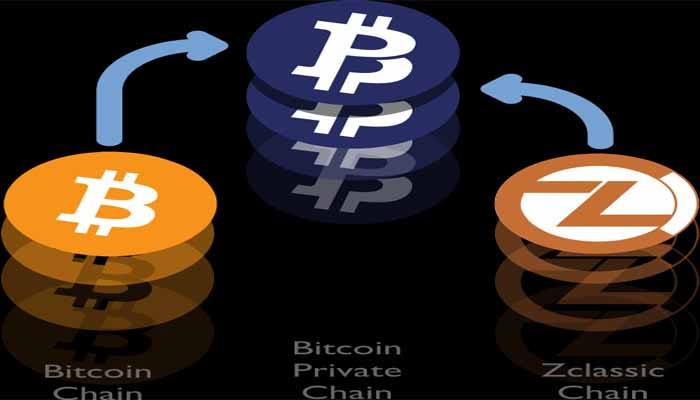
Roadmap
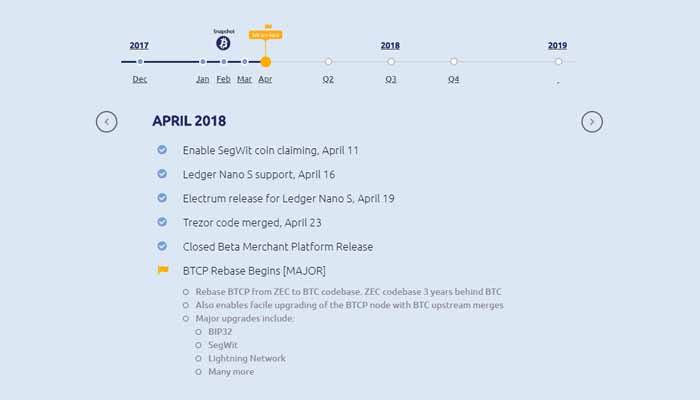
You Need To Know About Bitcoin Private
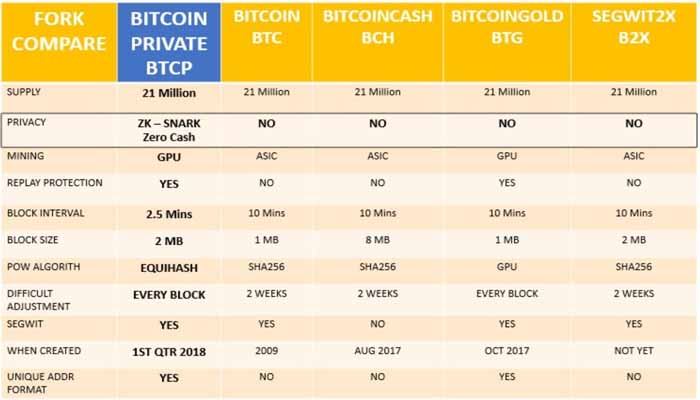
The upcoming hard forks for Bitcoin have not received near the coverage of the past three hard forks of Bitcoin: Bitcoin Cash (Bcash), Bitcoin Gold (BTG), and the canceled SegWit 2x fork (some thought it was postponed, including myself due to the confusion caused by the SegWit2x “2.0” fork, read more on it below).
There are reasons for this; firstly, they haven’t had the same effect among the community (drama, just look at Bitcoin’s community split between Bitcoin and Bitcoin Cash, it’s ridiculous) and secondly nowhere near the same proponents like Roger Ver and Jihan Wu behind Bitcoin Cash, big influencers in the Bitcoin and greater crypto community. They along with Bcash fans view Bcash as the real vision of Satoshi Nakamoto.
One thing anyone must note is treating forks of Bitcoin like altcoins. Despite the recent FUD (Fear, Uncertainty, Doubt) around Bcash and Bitcoin, you must understand their is only one Bitcoin. This doesn’t mean a fork like Bcash or BTG won’t be successful.
How do “I” receive BTCP?
What makes Bitcoin Private (BTCP) different about it from previous forks? Owners of both Bitcoin and ZClassic (ZCL) will receive BTCP at a one-to-one ratio upon the snapshot of the network. For example, if you own 10 Bitcoins and 30 ZCL, you will get 40 BTCP. For those unaware, ZCL is a privacy coin based on Zero Knowledge proofs (ZKP) that was forked from Zcash.
In order to receive BTCP, it is recommended you store your ZCL and Bitcoin in private wallets to guarantee you receive your tokens. ZCL’s only major exchange it is listed on is Bittrex, but Bittrex is yet to announce if they will support the fork.
The total circulating supply for BTCP will be 18,500,000 (Supply BTC + Supply ZCL) with a max supply of 21 million BTCP. The tech of BTCP will be that of Bitcoin Gold, but also with parts from Zcash/ZClassic. Payments for BTCP will be published on a public ledger, but the amount, sender, and recipient of the transaction remain anonymous.
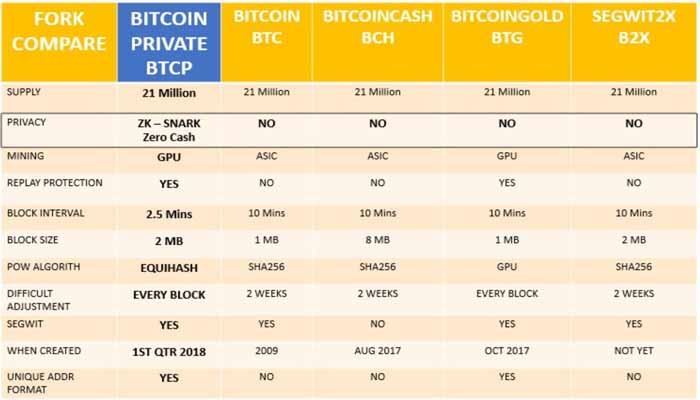
The founder of ZClassic, Rhett Chreighton is also the creator of BTCP. Rhett Chreighton had announced on Twitter in early December that he was teaming up with the original Zclassic founder Joshua (name on the Twitter account), who goes by the name Movrcx. The tweet stated that they were working actively on ZCL, and what they were working on was a purely mined fair launch ZK-SNARK tech with no founders reward.
- Overview - Table of Contents
- What Is Bitcoin Private?
- Getting Started With Bitcoin Private
- How To Get A Bitcoin Private Wallet?
- Bitcoin Private Resources
- How To Buy Bitcoin Private?
- How To Earn Bitcoin Private?
- What Is Bitcoin Private Mining?
- Latest Bitcoin Private News
ZKP offers the advantage of hiding the amount a wallet or individual may have. It is a way for a “Prover” to exchange a message with a “Verifier” to assure them that they have knowledge of a certain proof without declaring what that knowledge is.
There are parameters that must be satisfied for ZKP to work:
Completeness: If the statement is true, then an honest verifier can be convinced of it by an honest prover.
Soundness: If the prover is dishonest, they cannot convince the verifier of the soundness of the statement by lying.
Zero-Knowledge: If the statement is true, the verifier will have no idea what the statement actually is.
ZClassic Price Reaction
The market’s response to ZCL being part of the BTCP fork was nothing short of spectacular. In less than a week, ZCL went from roughly $7.50 all the way up to $120, a 1600% price change, taking it from a $4.5 million market cap to a $217 million market cap. Some would call it euphoric and FOMO, but with ZCL price now stabilized around $80, I only see it going up from here. For one, the BTCP hard fork is not till mid-to-late January. As the fork approaches, many people will choose to stack ZCL versus Bitcoin because they can obtain ZCL much cheaper, thus more BTCP.
ZCL price made a healthy correction to around $80, so I expect it to consolidate over the upcoming days and continue it’s uptrend as more people will pile into ZCL to get their “free” BTCP. With such a low circulating supply (1.8 million ZCL), it will move up fast once more people start trying to get their hands on it. A $1,000 ZLC is not out of the picture considering it would only have to see around a twelve times jump. With its current market cap at $161 million, that’s not infeasible.
I will say this- expect a hard dump after the BTCP snapshot. Many people will be buying up ZLC for the fork soon, so be weary if you decide to invest.
How To Get A Bitcoin Private Wallet?
Bitcoin Private (BTCP) can be managed from Ledger devices through the use of a third-party wallet Electrum BTCP. This article explains how to install the BTCP application on your Ledger device.
1. Ensure you can use Bitcoin Private with Ledger
- A Ledger Nano S is required.
- Make sure your device runs the latest firmware version.
2. Install the BTCP application on your Ledger device
- Launch the Ledger Manager. Refer to this article to learn how to install and use the Ledger Manager.
- Connect your Nano S and enter your PIN to unlock the device.
- Click on the green arrow button to install the BTCP app.
- Confirm using the right button in case the device displays Allow Ledger manager?
- Quit the Ledger Manager.
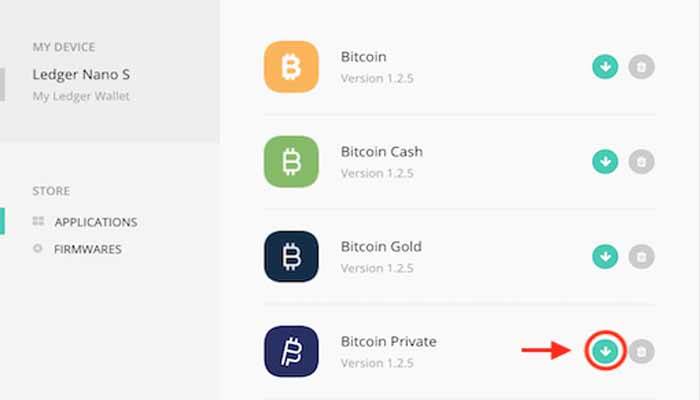
3. Open Bitcoin Private on your Ledger device
- Once the BTCP application is installed, use the left or right button to find it on the dashboard.
- Press both left and right buttons simultaneously to launch the app.

4. Install and Create an Electrum BTCP wallet
- Download the latest release of Electrum BTCP.
- If this is your first time launching, create the wallet by selecting Auto connect.
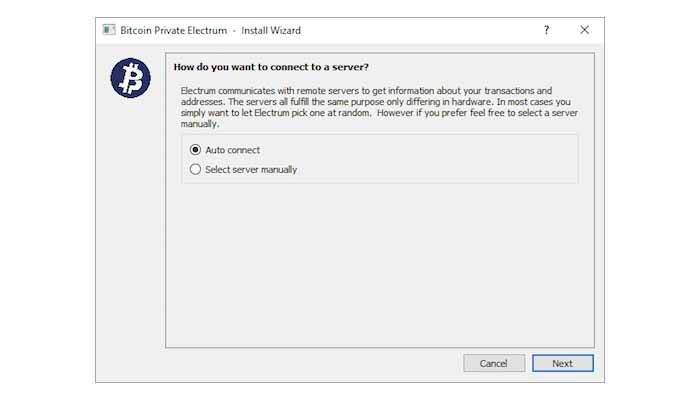
If you have used Electrum BTCP before, go to the File Menu and select File > New/Restore to create an additional wallet.

Choose a name for your wallet.
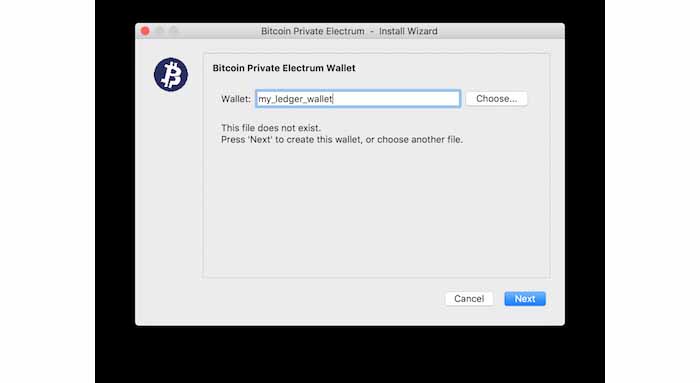
Next, choose Standard wallet.
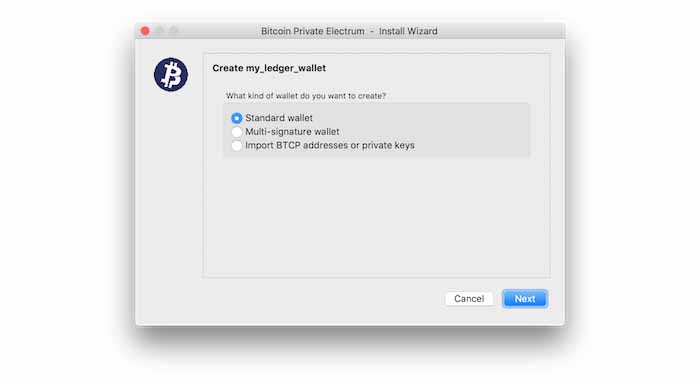
When asked about Keystore, choose the option Use a hardware device.
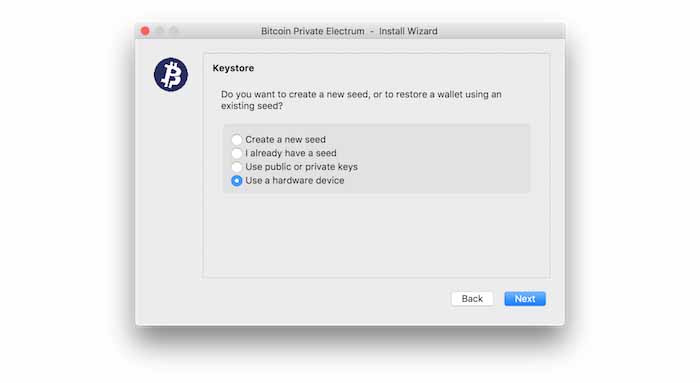
At the Hardware Keystore screen, always choose the first option listed.
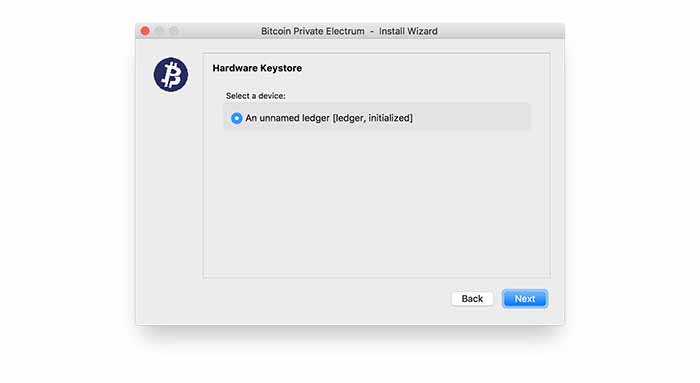
Leave the Derivation path on the default setting as shown below.
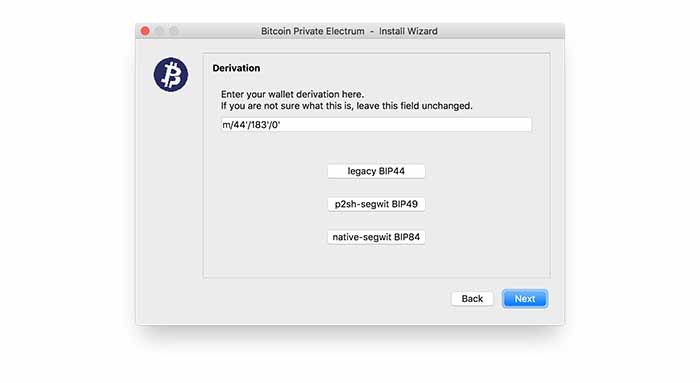
The Electrum main window will now open. From the View Menu, select View > Show Addresses to view the public addresses associated with your Nano S.
Troubleshooting and Support
Solutions to common issues are described below. Please refer to the Bitcoin Private community support page for more information and troubleshooting.
Note: This app is developed and supported by a third party on Ledger's platform.
At the Hardware Keystore setup screen, I get No Hardware Device Detected
Make sure your Nano is unlocked with your PIN in order for the device to be recognized.
Exception: Invalid Status 6700
Make sure the BTCP application is launched on your Ledger device.
Exception: Invalid Sequence
Make sure your Ledger device is unlocked with your PIN code.
Any other error on Windows when creating the hardware keystore
1. Open Windows Settings, navigate to Devices, find the Nano S device and select Remove device.
2. Unplug the device and then plug it back in.
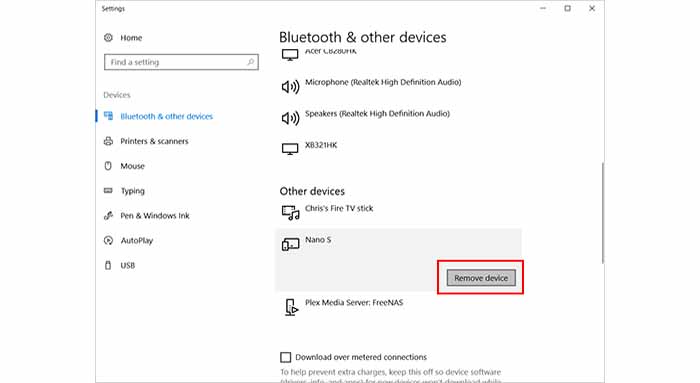
5. Recovering BTCP from BTC at the Fork
BTC Legacy Address (starts with a 1): create a new wallet and use this derivation path as shown below.
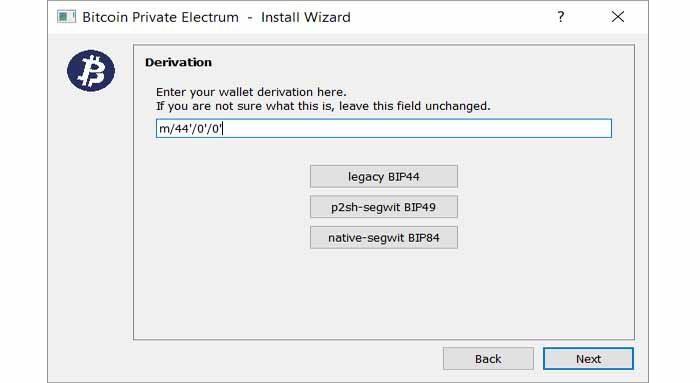
BTC Segwit Address (starts with a 3): create a new wallet and use this derivation path as shown below.
Note: Spending is currently disabled on version 1.1.1, but will be enabled soon on a subsequent update.
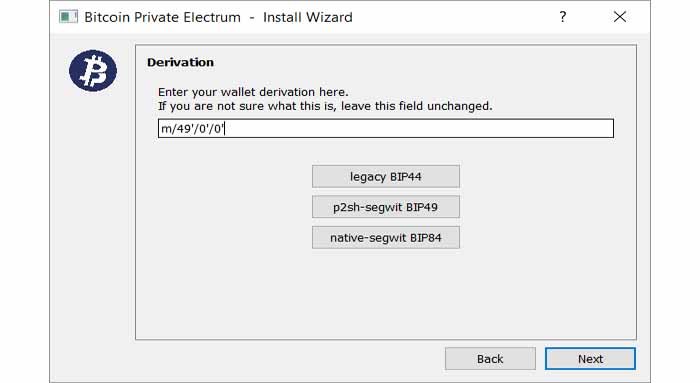
To send the funds, open the Coins tab on the main page.

Click spend and send to an address on your main BTCP enabled wallet.
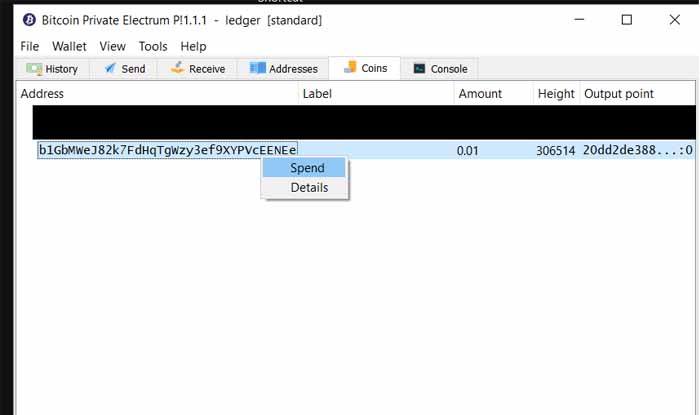
Spend the whole amount minus the transaction fee and click preview.
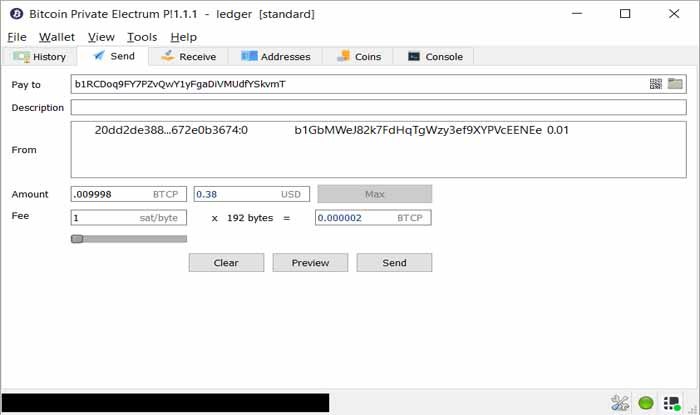
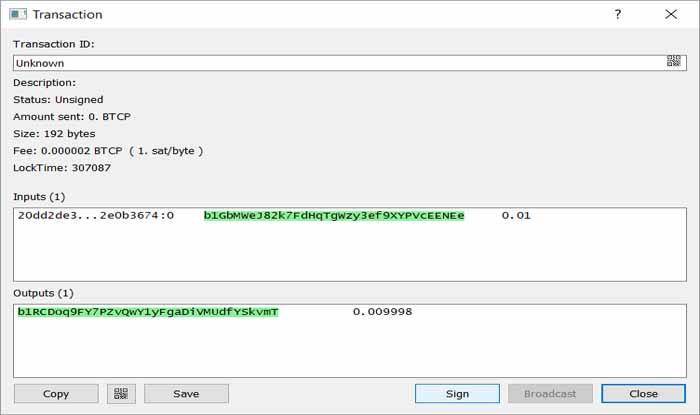
Note: You should only have 1 output and it should be the original Coin amount minus the transaction fee.
Sign and broadcast the transaction.
Web and Mobile Wallets
Most of the web and mobile wallet software services in the Bitcoin market store your private key on your behalf on their servers.
They get stored in an encrypted form which only you can decrypt.
Android Wallets:
- MyCelium
- Jaxx
- Coinomi
- SamouraiWallet
iOS Wallets:
- Breadwallet
- CoPay
- AirBitz
In this kind of wallet, your keys are held by someone else, and if that gets hacked or stolen, your bitcoins are gone. That is why you need to take extra safety measures when dealing with these services.
However, there are really great wallets like MyCelium, which I personally use because of its additional security features and compatibility with hardware wallets.
Desktop Wallets
Desktop wallets are relatively safe. In such wallets, once you install them on your desktop, you will get your Bitcoin address and private key in a downloadable and importable file.
These importable keys can be made password protected and stored on a memory stick or hard drive.
But once you lose the file of the private key, you will lose the bitcoins.
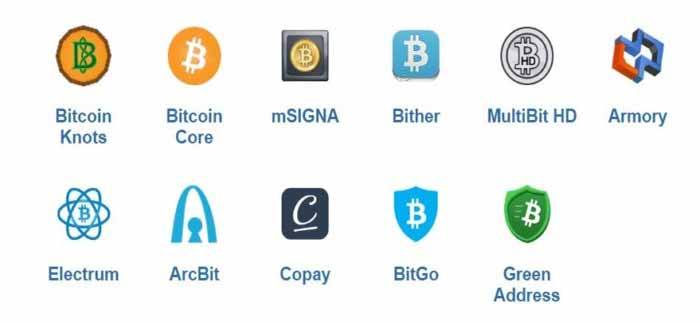
Hardware Wallets
Hardware wallets are basically an electronic invention made to store your private keys offline away from the vulnerable online environment so that they can’t be hacked.
Some hardware wallets come with security grid cards similar to some debit cards in order to verify the transaction. Some even have a little digital screen to verify your transactions.
They are temper proof and come with a limited user interface. In case your device is destroyed, as long as you have a backup code, you can retrieve your keys and bitcoins.
Some of the popular hardware wallets are:
Trezor
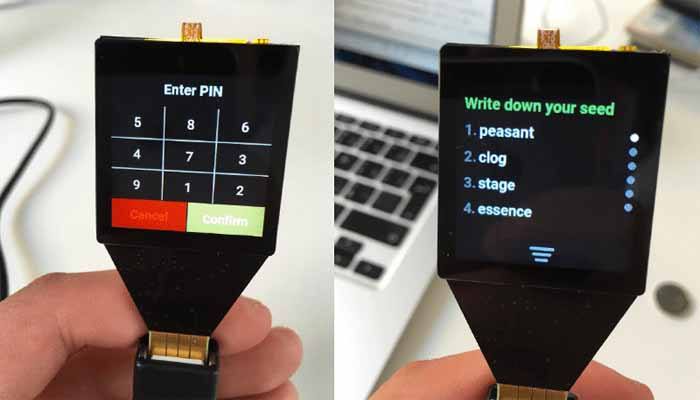
Trezor was the first hardware wallet to be launched since the invention of Bitcoin. It is a small device which can be connected via a USB cable to your personal computer. Its fundamental purpose is to store the private keys offline and sign transactions.
Ledger Nano S
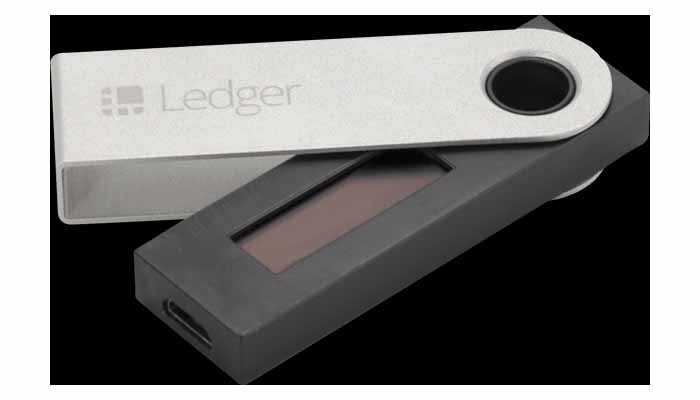
Ledger Nano S can be used even on a computer that is infected with malware. It has two buttons which are needed to be pressed together to sign and confirm a transaction, making impossible for a hacker to use.
Ledger Nano S also requires the user to create a PIN code on setup. The PIN code helps prevent the loss of bitcoins in case your Nano S gets lost.
It supports Bitcoin, Ethereum, and other popular altcoins, and connects with other software wallets like MyCelium. Here are few videos to learn more about Ledger Nano S:
Paper Wallets (Cold Storage)
Paper wallets are simply Bitcoin private keys printed on a piece of paper. It can have the Bitcoin public address also printed on it, but not necessarily. Paper wallets are an effective way of storing Bitcoin private keys offline.
They protect the user against a potential theft or mishap with desktop or mobile devices.
These kinds of wallets are also called “cold storage” because the keys are generated offline and never stored online or on a computer.
You can make your paper wallet from bitaddress.org, which is an HTML page specifically for this purpose only.
You can save the HTML page offline and remain disconnected from the internet to generate the keys. They can be printed on paper or stored as a soft copy on a USB or hard drive.
Bitcoin Private Resources
How To Buy Bitcoin Private?
Just like Bitcoin, Bitcoin Private will support peer-to-peer transactions without an intermediary. The transactions will be fast. Bitcoin Private will use the same privacy technology as ZClassic. This means payments are published on a public blockchain, but the sender, recipient and other transactional metadata remain unidentifiable.
A hard fork is when a single cryptocurrency splits in two.This case is a unique one, where ZCL and BTC both will be co-forked together into Bitcoin Private (BTCP).
How can I receive my BTCP coins?
According to the ZCL documentation on Reddit, BTCP Coins will be distributed on a 1:1 ratio. Example: (1 ZCL = 1 BTCP.) (1 Bitcoin = 1 BTCP.) (1 ZCL & 0.5 BTC = 1.5 BTCP.) The total combined amount of ZCL and BTC you own at the time of the snapshot will grant you eligibility to claim the same combined amount in Bitcoin Private. You do NOT need to hold a full amount of a coin. You can own partial amounts of ZCL/BTC.
So which coin should I buy to get more BTCP?
You will get the equal quantity of BTCP whether you are holding Bitcoins or ZClassic. So if you are going buy a coin to claim BTCP as the reward, you should buy ZClassic. BTC is currently trading at $10,967.10 and ZCL is trading at $87.77. Clearly, you can get more ZCL then BTC for your purchase and hence more Bitcoin Private coins you will get as reward after the fork.
How can I buy ZClassic (ZCL)?
ZCL is available at CoinSwitch. You can follow this step by step guide to buy ZCL at best rates: https://blog.coinswitch.co/how-to-buy-zclassic-zcl-aeb1a474328d

What Is Bitcoin Private Mining?
Bitcoin Private is a long awaited cryptocurrency that takes the best of bitcoin, makes it about 4x faster, and adds Zcash’s privacy (zk-SNARKS) aspect to it. It is the first fork that involved two different coins, both Bitcoin and Zclassic (a fork of Zcash).
Holders of Bitcoin and Zclassic received a 1:1 ratio of BTCP. This means if you had 1 BTC and 2 ZCL before the fork, you would have received 3 BTCP. The fork occurred on February 28th, 2018 and the mainet launch was around March 2nd, 2018.

Here is a quick chart that the Bitcoin Private team made, comparing BTCP to other BTC forks.
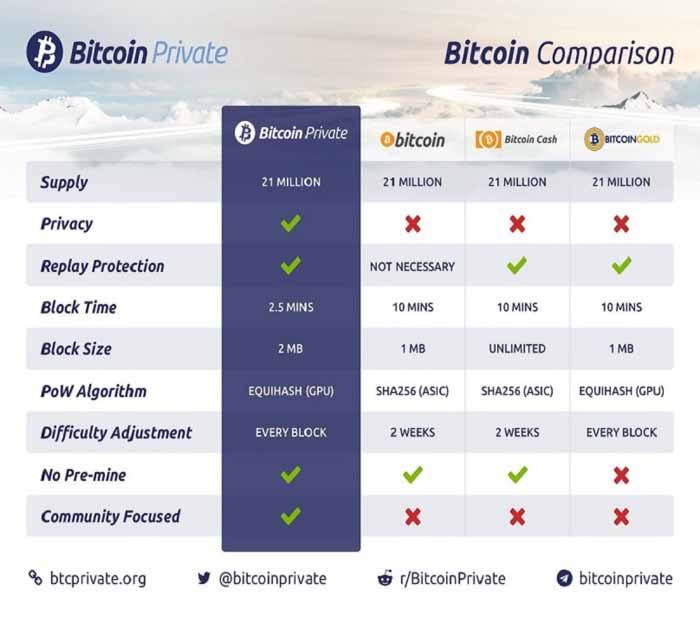
Some General Mining Tips
So before we start this tutorial, I have two tips for making the most out of your mining experience. First make sure you have the latest drivers for your GPU’s. Secondly, most mining software will get flagged as a virus from virus scanners. Because of this, if your mining on your normal everyday use or gaming computer that has an antivirus installed, you will want to exclude the mining software from the antivirus. What I like to do is I make one folder and then put all of my mining software in sub folders. I then exclude the top level folder from the antivirus and that excludes all the mining software.
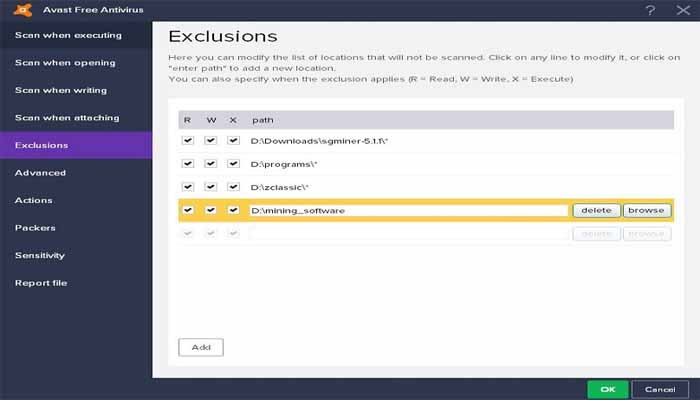
Mining Pools
The first thing we need is a mining pool. You can solo mine, but the payouts could take months depending on how powerful your mining rig is, and the mining pools usually charge a very small fee (1% or less). Using a pool will allow you to receive consistent payouts, multiple times per day. The bitcoin private team has an official list of most of the mining pools on their website.
- Son of a Tech http://equihash.sonofatech.com/
- WFMPools https://zpool.wfmpools.com/
- Coinblockers https://btcp.coinblockers.com
- Btcprivate.pro http://btcprivate.pro/
- Btcprivate.pro (solo) http://solo.btcprivate.pro/
- Vicious Miner http://viciousminer.com/
- Miningcrypto.cash http://btcp.miningcrypto.cash/
- Panda Mines http://pandamines.com/
On the website there are four different categories. The official mining pool is run by the BTCP team, and all fees go to the development of the coin. Sponsored pools are verified and donate a portion of their fees to the BTCP team. Verified pools mean they have tested the pools and know they pay. Unverified means they have not been tested by the BTCP team.
For this tutorial we will use http://btcprivate.pro – a sponsored pool. I have chosen this pool because of their unique features. Their a larger pool, they have servers in US,EU and Asia, they charge 1% fees and donate half of their fees to the BTCP team, they have an API as well as a page to check and change your miners settings, and they have a custom payment threshold. This means you can bundle your payments into one payout per day, per week, or whenever you want!
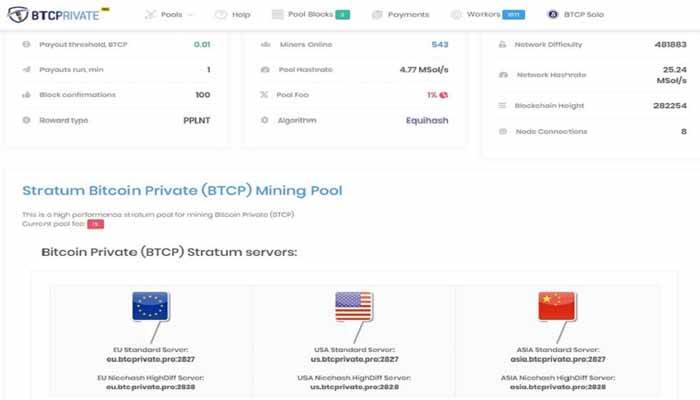
Now that we have a pool, lets start mining.
CPU Mining
Their are only two options for mining Equihash using a CPU. One is Minergate, but I don’t prefer them because they take a large percentage of your profits because of the easy to use system they have. The only real miner is Nicehash’s nheqminer. You can download the precompiled binaries for Windows or Linux.
We will not focus on CPU mining since it is not profitable, compared to GPU mining.
GPU Mining – Nvidia
For GPU mining there are many programs for Nvidia, but the one I have found to be the best is EWBF’s CUDA miner. The miner does have a 2% Dev fee. The miner is compatible with Windows and Linux. You can find the official page and the download link at https://bitcointalk.org/index.php?topic=1707546.0
Once downloaded, it is really simple to use.
Just create a new batch file (or script file if using Linux) inside the folder where the miner is and paste this into the batch file.
miner --server miningpool --port port --user wallet_public_key.worker --pass x --pec
Replace “miningpool” with the server you want (eu.btcprivate.pro, us.btcprivate.pro, asia.btcprivate.pro)
Replace “port” with the port you want (2827 is the only option)
Replace “wallet_public_key” with your wallet address. Make sure you use the transparent address, it starts with a b and not the shielded address, it starts with a z
“Worker” is optional. Use this if you have multiple mining computers. For example I could do b1PR4MkpD5BpRu6BUbX1uCz9ptuPzjoY3FP.officecomputer for one computer and then b1PR4MkpD5BpRu6BUbX1uCz9ptuPzjoY3FP.gamingcomputer for another computer.
This way you can keep track of them on the pools dashboard.
Double click the batch file to run the miner, and you should see something like this
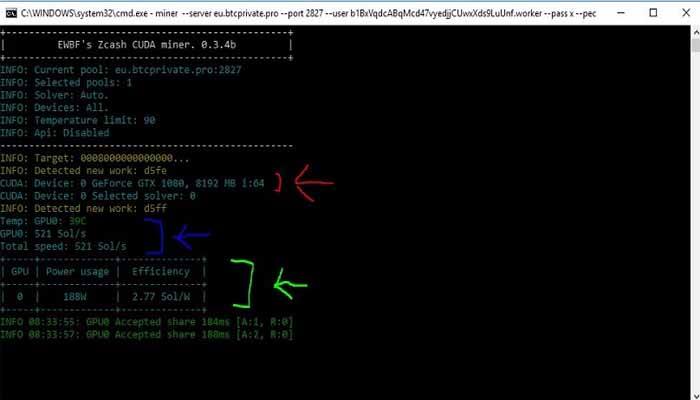
Where the red arrow is on the picture, this means the GPU’s it has detected. The blue arrow indicates the temperature and speed for each GPU as well as the total speed. The green arrow indicates the power usage for each GPU.
GPU Mining – AMD
For GPU mining there are many programs for AMD, but the one I have found to be the best is Claymore’s ZCash miner. The miner hash a 2.5% Dev fee, or a 2% Dev fee when using a SSL connection. You can find the official page and the download link at https://bitcointalk.org/index.php?topic=1670733.0
If you need the Linux version get it at https://github.com/nanopool/ClaymoreZECMiner/releases
Once downloaded, it is really simple to use.
Just create a new batch file (or script file if using Linux) inside the folder where the miner is and paste this into the batch file
setx GPU_FORCE_64BIT_PTR 1
setx GPU_MAX_HEAP_SIZE 100
setx GPU_USE_SYNC_OBJECTS 1
setx GPU_MAX_ALLOC_PERCENT 100
setx GPU_SINGLE_ALLOC_PERCENT 100
ZecMiner64.exe -zpool miningpool:port -zwal wallet_public_key.worker -zpsw x -allpools 1 -i 8 -asm 1
If using Linux, remove all of the setx commands.
Replace “miningpool” with the server you want (eu.btcprivate.pro, us.btcprivate.pro, asia.btcprivate.pro)
Replace “port” with the port you want (2827 is the only option)
Replace “wallet_public_key” with your wallet address. Make sure you use the transparent address, it starts with a b and not the shielded address, it starts with a z
“Worker” is optional. Use this if you have multiple mining computers. For example I could do b1PR4MkpD5BpRu6BUbX1uCz9ptuPzjoY3FP.officecomputer and then b1PR4MkpD5BpRu6BUbX1uCz9ptuPzjoY3FP.gamingcomputer
This way you can keep track of them on the pools dashboard.
If you are running large GPU’s (1GB of memory or more per GPU, jump down to #5 under the problems section, even if the mining software appears to work)
Double click the batch file to run the miner, and you should see something like this
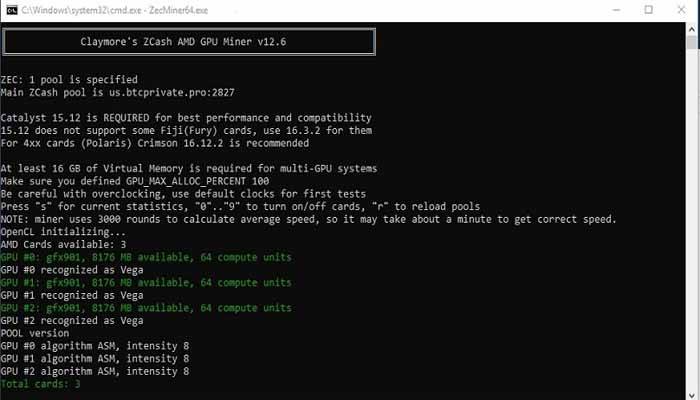
The first image shows that the miner should pickup all of the GPU’s in your system (The 3 Vega GPU’s in my example)
The next image shows The GPU temperatures and fan speed where the red arrow is, and the GPU speed and total speed where the blue arrow is.
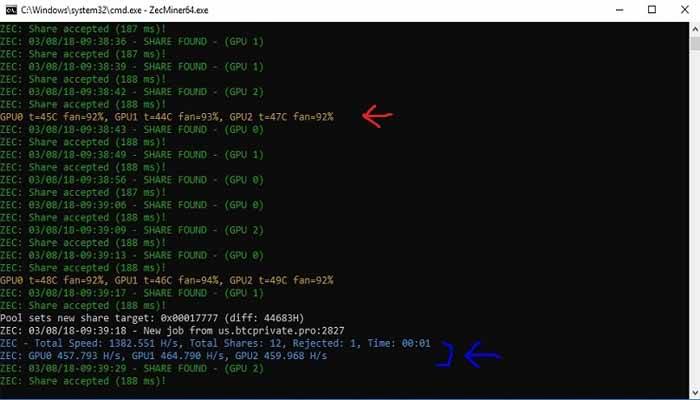
If there are problems, you can try a few things.
- Use -asm 0 or don’t use the asm flag instead of using -asm 1. Note for Vega cards you have to use -asm 1 otherwise you will get an error.
- Try not using the setx commands. For Vega cards I got an openCL error before I used these options.
- If you get a invalid pool error try adding or removing the -allpools flag.
- If your miner crashes after a while try to lower the intensity by using -i 6 instead of -i 8
- You may not have enough virtual memory. You may need 16GB of virtual memory (for Vega GPU’s you need more like 16GB per GPU) to change this go to Control Panel -> System and Security -> System and the click Advanced system settings on the left. From their click settings under the advanced tab. Next click change, and then on the third screen, uncheck automatically manage, choose custom size, and type in the size (in MB) for both text boxes. Then press the set button, and then the Ok button.
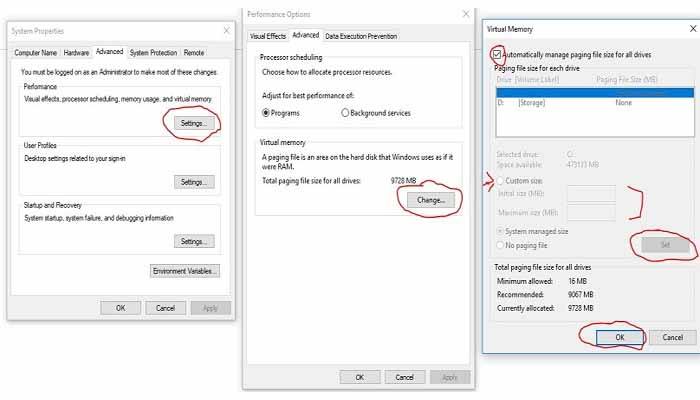
General Troubleshooting
One thing to monitor for is stale or rejected shares. If you see a lot of stale shares, you may want to try a server that is closer to you. If you see a lot of rejected shares, try to lower the intensity of the miner if available.
How Much Bitcoin Private Will I Earn Per Day?
Usually to figure this out, you would go to http://whattomine.com and use their calculator. For example https://whattomine.com/coins/167-zcl-equihash you can type in your speed, power usage and electricity cost and see a rough estimate of how much ZCL you would mine in one day, as well as how much that is in USD.
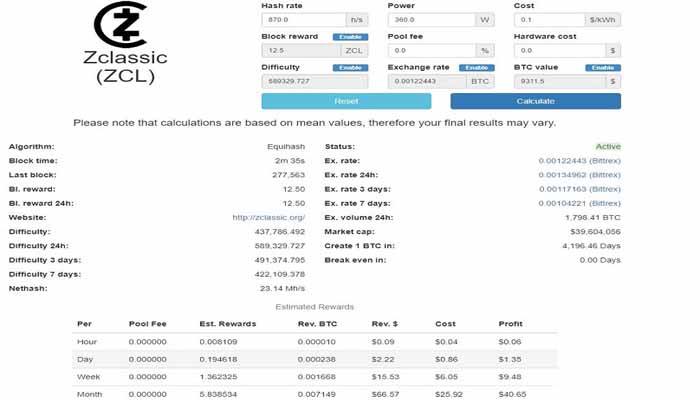
Because BTCP was released last week there’s no calculator available yet. However, we can use a formula to determine a rough estimation.
block_reward / ((network_hash_rate/your_hash_rate*block_time) / (60*60*24)) * percentage
For BTCP we have:
- block_reward = 1.5625
- network_hash_rate = changes constantly. From the http://www.btcprivate.pro homepage image it showed 25.24Msol/s so we have to convert to sol/s so 24.25*1000*1000 = 24250000
- your_hash_rate = on the AMD system picture it shows about 1383
- block_time = 2.5 minutes but it is more like 3 minutes so 3*60 = 180 seconds
- percentage = would be 100% but we need to subtract the pool and miner software fee so 100-(1+2.5) = 96.5%
With our example we would get
1.5625 / ((24250000/1383*180) / (60*60*24)) * 96.5% = 0.041
So this means we would have a rough estimate of 0.041 BTCP per day.
That’s it. You should now be mining BTCP. Make sure to type in your public key into the mining pool’s dashboard, to keep track of your statistics, and to set your custom payout options.
Latest Bitcoin Private News
Update on the Bitcoin Private Donation Treasury
Below you will find a summary of the BTCP donation treasury, which we intend to release quarterly. This statement is slightly before the end of the quarter and before the end-of-the-month bounty payouts to team members for successfully achieved objectives. The next update will come at the beginning of July 2018, and in the future, will be released approximately one week after every quarter closes. We want to be clear that we have been working with a well known nationwide accounting firm that formally maintains the treasury’s accounting books since February, 2018.
- Overview - Table of Contents
- What Is Bitcoin Private?
- Getting Started With Bitcoin Private
- How To Get A Bitcoin Private Wallet?
- Bitcoin Private Resources
- How To Buy Bitcoin Private?
- How To Earn Bitcoin Private?
- What Is Bitcoin Private Mining?
- Latest Bitcoin Private News
In this update, you will note that there are quite a few figures shown. You can see how much ZCL was donated, how much was spent, and how much was traded. You can see how much BTCP was obtained from ZCL/BTC via the hard fork, how much BTCP was traded for (via ZCL), and how much has been spent (none has been traded nor do we intend to trade BTCP unless necessary for an expense). The amount of BTC we traded for is also present (the large majority being before the fork to hedge) along with how much was spent.
Finally, you can see the breakdown of how many coins plus network txn fees have been spent in the various categories. A current USD value has been associated with each currency with the goal of showing a rough percentage breakdown of category expenditure. It is important to note that we have recorded the time of each transaction and at the end of the year, the engaged accounting firm will perform a full breakdown of the exact USD value of the currency at the time of transaction; this process will give us a total USD spent amount. We are more than willing to make this USD equivalent amount public in the first quarter of next year.
Please be advised there are minor discrepancies that are likely caused by missing transactions fees (for example, we actually have slightly more BTCP in our multi-sig than the spreadsheet says we should have). In some cases, we have had to convert BTC to USD in order to pay for various expenses (legal fees, accounting fees, past conference fees, Google Cloud hosting fees, etc.) and there are likely some transaction fees in this process we have not accounted for. Regardless, we will continue to perform our due diligence to fix these minor discrepancies.
As a final note, we have collected around 90 BTCP via the BTCP Contribution Team mining pool plus generous donations from other BTCP mining pools. Furthermore, we have collected around 13 BTCP in general donations. We keep these funds in a separate wallet so that we can continue to monitor these donations for tax purposes. None of these donations have been spent yet. Thank you to all those who continue to donate to the team.
